Suchergebnisse
Design Guidelines - Solar Space Heating of Factory Buildings

This booklet presents a method to design solar thermal systems for space heating of factory buildings using underfloor heating systems.
Mitteilungsblatt "Biobased Future" - Nr. 4/Juli 2015

Mitteilungsblatt über Biomasse für Energie und Industrie in einer nachhaltigen Wirtschaft
Herausgeber: Bioenergy 2020+
Downloads zur Publikation
IEA IETS Task 22: Climate Resilience and Energy Adaptation in Industry under Uncertainty (working period 2024 - 2026)
The main objective of this task is to promote understanding and progress in digitalization, artificial intelligence (AI), and related technologies in order to enable climate resilience (extreme weather and events) and energy adaptation (electricity, heating, and sector coupling) in energy-intensive industries. Specifically, the challenges of energy flexibility and demand response will be identified by means of surveys of Austrian stakeholders and the results presented nationally in a workshop format.
Energy R&D 2024: Public Expenditures in Austria
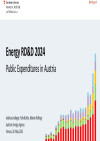
Public expenditure on energy research amounted to €401 million in 2024, an increase of €90 million over the previous year. New RTI initiatives, IPCEI, research infrastructure and a good mix of open-ended and thematic formats contributed to this increase. The top topics were hydrogen and energy efficiency in industry.
Schriftenreihe
25/2025
A. Indinger, F. Bettin, M. Rollings
Herausgeber: BMIMI
Deutsch, 155 Seiten
Downloads zur Publikation
Innovative construction
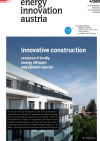
resource-friendly, energy efficient and climate-neutral
energy innovation austria
4/2021
Herausgeber: BMK in cooperation with the Climate and Energy Fund
Englisch, 12 Seiten
Downloads zur Publikation
Energy R&D 2021: Public Expenditures in Austria
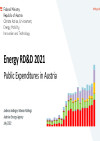
The public energy research expenditures amounted to 224.1 million euros in 2021, thanks to the economic stimulus plan. This is the highest value so far and an increase of 44.4%.
Schriftenreihe
22/2022
A. Indinger, M. Rollings
Herausgeber: BMK
Englisch, 123 Seiten
Downloads zur Publikation
IEA 4E EDNA: Electronic Devices and Networks Annex (Working period 2022 - 2024)
By 2030, the number of network-connected electronic devices worldwide is expected to exceed 100 billion, resulting in significant consequences for global energy consumption. The IEA 4E Electronic Devices and Networks Annex - EDNA therefore aims to develop policy recommendations to promote the energy efficiency of network-connected devices, and make those project results available to key stakeholders such as policy makers and product developers in the form of reports, policy briefs and tools.
Workshop: Biomass Supply Issues and Solutions
14. May 2007 - 16. May 2007
Hotel Schwärzler
Bregenz, AT
The workshop represents a regular event of this three year period of Task 29 activities. It provides an opportunity for specialists and non-specialists alike to learn and participate in an action focused on understanding the complex social and economic interactions of bioenergy and community.
7th international biogas networking conference
22. - 23. June 2010
Milan, IT
Unlocking the potential of Pan-European biogas production
e80^3-Buildings - Sub project 5: Monitoring and dissemination
The content of subproject 5 was the analysis of energy- as well as building-biology-related issues for the evaluation and quality management of the demo-project in Kapfenberg, which involves a high-quality refurbishment to a plus energy house within the program "Haus der Zukunft - Building of Tomorrow". Within this process the user acceptance before, during and after the renovation was elevated and this will be processed for upcoming projects. The environmental quality of the building regarding the choice of materials and measures during the construction phase and the subsequent use of the building was assessed with the help of the TQB-planning and evaluation tool.
Spatial Energy Planning for Smart City Quarters and Smart Regions
In the project ERP_hoch3 energy related policy research in three Austrian agglomerations (Vienna – Lower Austria, Graz – Styria and Vorderland-Feldkirch) has been done, scenarios of the current state and the target state have been modelled and calculated. The aim was to develop generic transferable recommendations for spatial energy planning in agglomerations.
Kierling passive house - heading into the future sustainably
Using the example of demonstrational renovation, Kierling (built between 1977 and 1979) tests the possibilities of a renovation in passive house standard in technical, organizational and financial terms as an outstanding example of a comprehensive renovation.
Producing with Solar Energy
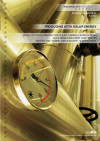
4/2003
Herausgeber: BMVIT
Englisch, 6 Seiten
Downloads zur Publikation
Industry Newsletter: Solar and Heat Pump Systems
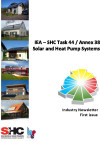
IEA - SHC Task 44 / Annex 38
M. D'Antoni, R. Fedrizzi, W. Sparber
Englisch
Downloads zur Publikation
Analysis of Long-Term Performance of PV Systems
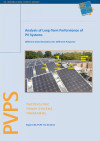
IEA-PVPS Task 13, May 2014
Herausgeber: IEA Photovoltaik Power Systems Programme
Englisch, 60 Seiten
Downloads zur Publikation
"Energy saving" - the best PR strategy for sustainable housing?

The project aim is the clarification and PR-reevaluation of the thematic field "energy/energy saving" as a chance to study users and market forces close and factual to have a secure base for the development of new concepts, slogans and incentives in Austria.
Working Party on Renewable Energy Technologies (REWP)
Central tasks of the Renewable Energy Working Party (REWP) are to support the IEA research programs, discuss current energy and technology policy issues among the IEA member states, advise the IEA Secretariat in Paris on issues related to R&D, technology and market introduction, and support the IEA in their outreach strategy.
IEA ISGAN Working Group 6 Transmission and Distribution Network Systems (working period 2023-2024)
IEA ISGAN Working Group 6 addresses the challenges in the overall system of transmission and distribution networks for electricity. The results will improve the understanding of the impact of smart grid technologies on the overall system performance, transmission capacities and operational management of public electricity supply systems. In the project years 2022-2023, international pilot projects on flexibility use and the necessary interaction of transmission and distribution grid operators will be summarised and conclusions drawn.
e-genius.at: The Open Content knowledge and learning platform
The objective of the project was to develop online teaching materials on the topics energy-efficient buildings and renewable energy sources in collaboration with technical vocational schools and vocational higher secondary schools.
